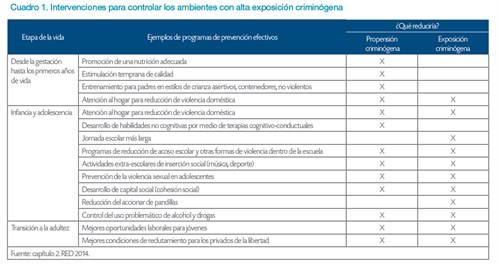Crime prevention with public policies focused on people
Being a criminal is not a permanent characteristic of individuals, as many who at some point committed a crime do not do it again. This implies that there are policies that may help get out of a criminal life as well as reduce the start of criminal activities
The typical age-criminality profile shows that most crimes are committed by young people. At the same time, there are two types of criminals:
- "Circumstantial" criminals: those who commit crimes but then stop doing so
- "Career" criminals: those who keep commiting crimes.
While circumstantial criminals are many (40 percent of the population with a high risk of criminal propensity), career criminals are the ones who accumulate the largest number of crimes, more severe, and which increase in time as they remain in their criminal career.
As an example, during an epidemy there are protective factors (good health) and promoters (presence of the virus) in infections; in the case of crime, the protective factors make the "criminal propensity" of the individual (a low propensity acts as a protective factor), while promoter factors are linked to the routine with which the individual faces risk situations, determining his "criminal exposure". According to the approach adopted in the 2014 RED, criminal propensity and exposure interact with the environment at a given moment, creating a criminal situation that may lead to crime.
The creation of the criminal propensity is a process similar to the development of cognitive and non-cognitive skills in people, which starts early in life and has several windows of opportunity (critical and sensitive periods) in which investments can be made that limit its growth, where the most profitable are those that focus on the first stages of life and which place a great emphasis on the role of the family (feeding, education, health, etc.). .
Criminal exposure is strongly influenced by the social interactions that characterize the daily routines of an individual. There is also empiric evidence that supports the effectiveness of certain interventions to control the environments that have a strong criminal exposure.
It should be noted that the positive impacts of interventions may take some time to materialize. Finally, the best empirical evidence comes from countries outside of Latin America, so it is necessary to have more in-depth knowledge of how they would work in the specific context of the countries of the region. For this, it is key to improve the statistical information systems with respect to citizen safety.
To read more about this topic, download for free the 2014 RED report "Por una América Latina más segura. Una nueva perspectiva para prevenir y controlar el delito" (For a Safer Latin America. A new Perspective to Prevent and Control Crime").

CAF's more recent content

CAF, ECLAC, IDB and PAHO Promote Sustainable Development in the G20
The Regional Organizations of the Americas congratulate Brazil on its successful G20 Presidency, highlighting its leadership on key issues such as poverty, governance, and climate change. They also reaffirm their commitment to actions that promote equity and development in the region.
Urgent Call for Action to Safeguard Caribbean SIDS at CAF Symposium
As the global community grapples with the escalating climate crisis, Caribbean Small Island Developing States (SIDS) are running out of time to secure critical investments and support needed to strengthen their economies and protect vulnerable communities from the intensifying impacts of climate change. With the window to take decisive action rapidly shrinking, CAF - Development Bank of Latin America and the Caribbean, in partnership with the Commonwealth Secretariat and the Antigua and Barbuda High Commission, brought together key stakeholders for a symposium in London to address the critical vulnerabilities Caribbean SIDS face.